The Desktop Kabini Review Part 1: AMD Athlon 5350 (AM1) Tested
by Ian Cutress on April 9, 2014 8:00 AM ESTIGP Comparison, Synthetics
AMD’s graphics stack from top to bottom is all based on the Graphics Core Next architecture. This is an update from earlier VLIW implementations, offering for scalability from low power all the way up to high performance. At the heart of an AMD graphics system is the compute unit comprising of 64 GPU cores. Each compute unit can act independently, ensuring that multiple tasks can complete as quickly as possible due to multiple kernel dispatch across the entire core. In the Kaveri APU launch we were dealing with APUs that contained 6 or 8 compute units for 384/512 cores. With this level of performance, gaming at 1080p30 was possible on most titles depending on how the quality settings were configured. For Kabini, the entire range is given two compute units, with individual processors differing in clock speed.
With two compute units, we are not expecting much from the gaming aspect of these APUs in terms of ‘the latest’ titles. Our benchmarks in the next few pages show that even F1 2013 at 1280x1024 on low settings, unless the engine powering the game is basic, 25 FPS minimum is a hopeful target. This lack of horsepower may limit these APUs to Flash based titles, perhaps even some of the more reasonable Unity games. In AMD’s slide deck they quote games such as Minecraft, Lego Marvel Superheroes and Bastion as the sort of titles that a Kabini player should aim for.
There is some confusion regarding the naming convention of these integrated graphics solutions. Soldered on Kaveri parts designed for all-in-ones, such as the A6-5200, use the HD8000 naming scheme, such as the HD8400. The Athlon 5350 is analogous in design to the A6-5200 except for a 50 MHz speed bump and the name of the IGP – here this is designated as the R3 series. This is despite retailers who are currently selling this APUs and labeling them with the HD8000 designations.
Like Kaveri, the integrated graphics solution in Kabini features an updated Video Codec Engine and Unified Video Decoder giving hardware support for H.264.
AMD is also promoting their Picture Perfect solution, using additional post processing tools to increase video quality on the fly:
Also rather interestingly AMD is claiming an enhanced decoder for JPEG files. Given that one of the primary uses for a Kabini system might be for web access where JPEGs are standard, AMD has been promoting up to a 2x performance increase over a J2900 system:
AMD’s secret sauce, according to their slides, appears to be heterogeneous computing. This would be the ideal usage scenario for computing going forward.
GPU Synthetics
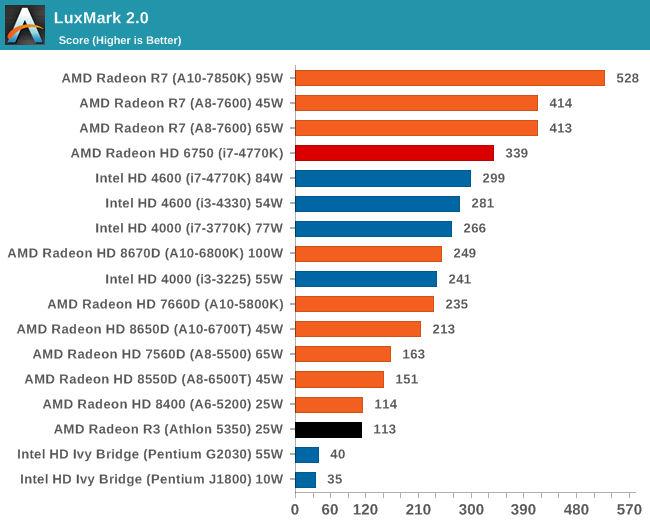
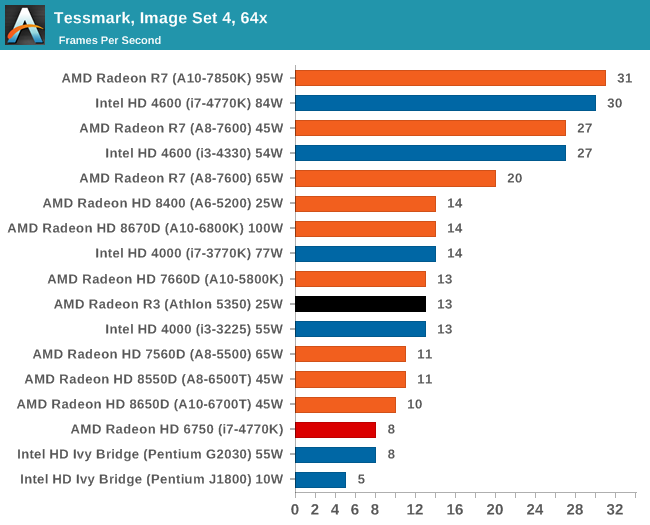


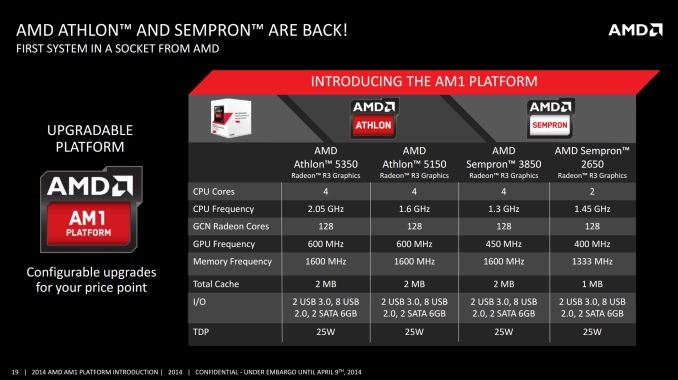
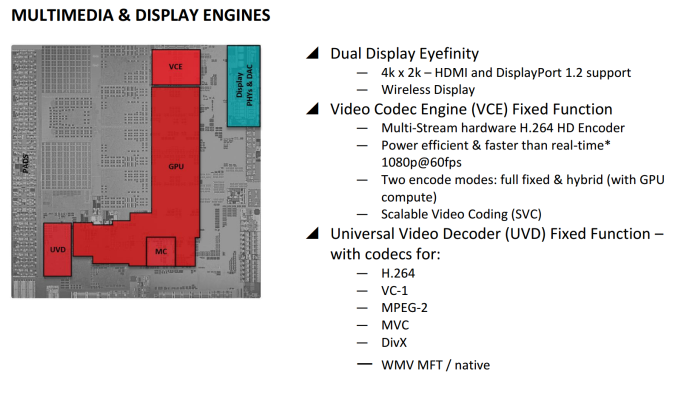
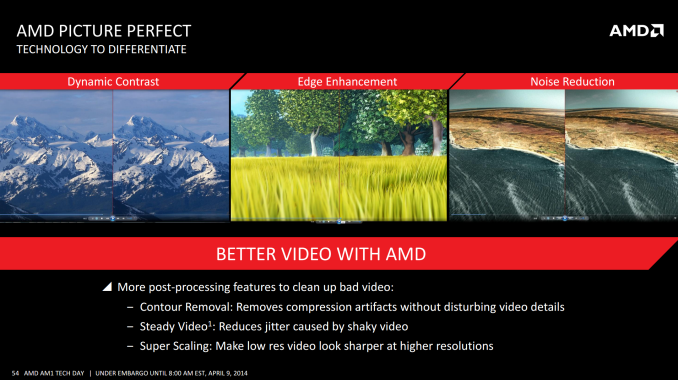
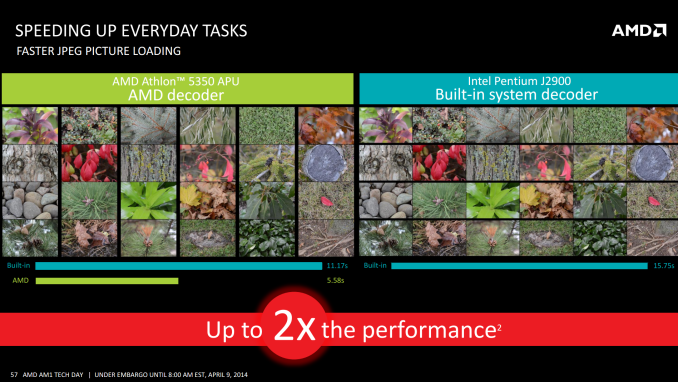
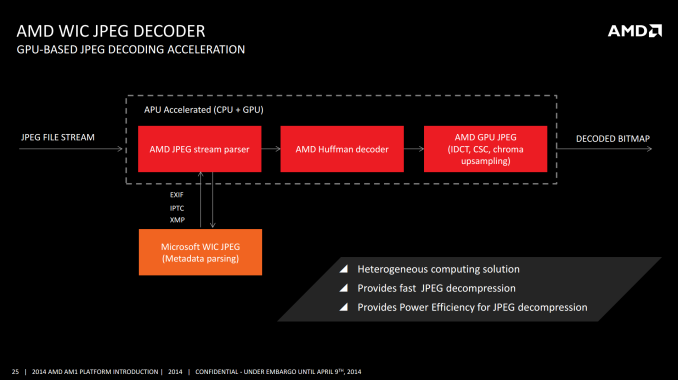








126 Comments
View All Comments
Medallish - Wednesday, April 9, 2014 - link
Indeed, I loved building one, but it's kind of hard to advertise it being insanely cheap, and advertising upgradeability, you are more likely to simply purchase something new entirely when upgrading, if they are able to upgrade AM1 CPU's greatly, like lets say the next Mullins or Beema fits in effortlessly and introduces new stuff like Dual Channel DP 12a, or HDMI 2.0, and it worked on older boards, then I would say AMD had a nice idea, but the question really comes down to, at this price point do people even care about upgradeability?mikato - Friday, April 11, 2014 - link
The good thing is that if/when you do upgrade and get a Beema, you're upgrading both the graphics and the CPU, hopefully both significantly.mrdude - Wednesday, April 9, 2014 - link
I'm actually fond of AMD's APUs and their direction with respect to heterogenous computing (I think it'll succeed even if AMD goes out of business, personally), but I agree with you.Providing a socketed platform is great, but without a clear direction and upgrade path it's all for naught -- and I mean AMD needs to state that Beema will be available on X date and features Y improvements. Nobody with more than a few brain cells buys into a platform that offers nothing outside of 'wait and see.'
AMD also needs to come to grips with the fact that on-die GPUs aren't going to taken seriously until they can provide playable framerates at 1080p without substantially increasing platform cost. Kaveri does the first part very well, but the memory scaling and memory cost issue really hamstring the platform. Pushing for beefier graphics makes sense in the tablet space where Mullins is supposed to make headway, but on the laptop/desktop side it's next-to-worthless unless it can play modern titles at 720p or 1080p at medium settings.
And Kabini desperately needs an aggressive turbo core and dual-channel memory. Kanter's article shows a very potent little microarchitecture, but those two points are really holding it back.
I think Jaguar is a better microarchitecture than Steamroller, but it seems clear to me that AMD isn't giving it the sort of attention that I feel it deserves.
JDG1980 - Wednesday, April 9, 2014 - link
Backtracking on GDDR5 for Kaveri was a big mistake. Without the added memory bandwidth, the iGPU is bottlenecked, and the result is that Kaveri barely offers any improvement over Richland at all.Musafir_86 - Wednesday, April 9, 2014 - link
-It's Mantle time!-On a serious note, please test any GCN 1.1 card (Bonaire & Hawaii), and also GCN 1.0 card with BF4 & Thief in Mantle mode, pretty please! Don't let that ×16 slot go to waste!
Regards.
otherwise - Wednesday, April 9, 2014 - link
Looking at those CPU benchmarks, I would argue if you're even considering using an external GPU with this system you should be looking elsewhere. It's not really cheaper than a low end celeron system; and even atom is beating it in CPU power.Flunk - Wednesday, April 9, 2014 - link
I don't think he wants to see how it performs because he's thinking of building a rig like that. It would however be a good way to see how the reduced CPU overhead of Mantle affects GPU performance.Medallish - Wednesday, April 9, 2014 - link
Honestly it would be kind of fun/interesting to see if Mantle will have an impact at such a low-end system, I mean likely the CPU will be bottlenecked simply using a 260x.munim - Wednesday, April 9, 2014 - link
How does it work for everyday use? Web browsing, 1080p youtube, things of that nature?JDG1980 - Wednesday, April 9, 2014 - link
They don't bother testing that since any modern system will do it just fine.There were a couple of JavaScript benchmarks (SunSpider and WebXprt) at the bottom of the 'CPU Productivity' page.